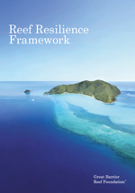Stakeholder Engagement for Resilience Planning
Location
Ningaloo Reef, Western Australia
The challenge
Effective stakeholder engagement – the process of informing, understanding, and responding to the concerns of anyone who may influence, or be influenced by, a management decision – is fundamental to effective planning and management. When done well, stakeholder engagement can provide valuable feedback which improves decision-making and builds public support for particular decisions. It also develops social license and public trust in managers more generally, which is fundamental to the successful implementation of actions. However, in many cases, stakeholder engagement is treated as a ‘tick-the-box’ exercise, often in the form of a public consultation period which allows comment on a strategy or action which is already developed but does not provide meaningful opportunities for participants to shape the approach or priorities. In circumstances where agencies must rely on ongoing support or cooperation of the public, this can have negative effects on levels of trust in management over time and hamper implementation of actions or other planning processes which follow. In this sense, stakeholder engagement should not be seen as a discrete step that must be performed, but the first step in building the trust, relationships, and support that will be required for ongoing management.
Actions taken
This case study outlines lessons learned from the process of engaging the community to design a Resilience Strategy for the Ningaloo Coast in Western Australia. The Resilience Strategy aims to support and sustain Ningaloo’s coral reefs and the people who depend on them. The strategy is housed within the Department of Biodiversity, Conservation, and Attractions (a State Government body in charge of coral reef management in Ningaloo) and was developed with the support of the Resilient Reefs Initiative. Resilient Reefs is a global initiative to support coral reefs and communities to adapt to climate change and local threats within five UNESCO Marine World Heritage sites. Key to achieving this is the development of a Resilience Strategy focused on the reef ecosystem, community well-being, and governance arrangements. Click here (or on image) for an in-depth look at the resilience framework developed and utilized by the Resilience Reefs Initiative.
To develop the strategy for Ningaloo, over a period of eight months, we engaged stakeholders to understand their concerns, values, and priorities; provided information where necessary; and then co-designed actions which addressed key threats to coral reefs and communities. Stakeholders representing local councils, other management authorities, community groups, local businesses, indigenous groups, scientists, community members, and specific interest groups and industries were reached using a wide variety of methods, including:
- Interviews: To understand key concerns and views we interviewed 60 stakeholders who were known to reef managers to be influential members of the local community. Interviewees were asked to suggest others who should be interviewed. The ‘snowball technique’ allows managers to quickly identify the network of influential people.
-
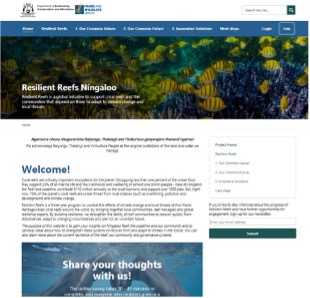
Ningaloo’s interactive online platform for stakeholder engagement
Online surveys: As a result of Covid-19 and restrictions on interactions, we designed an online survey for feedback on key values, priorities, and threats that are important to address. This interactive platform also allowed participants to see the responses of others and to engage in discussion or ‘like’ (show support for) ideas.
- Community workshops: Using the feedback from interviews and online surveys, we undertook whole-of-community workshops for participants to discuss their knowledge, experiences, and opinions with others. This was perhaps the most important and productive step of the engagement as it not only gave people the chance to express their opinions, but also to consider and revise those opinions in the context of other issues and priorities which were shared by the group.
- On-country engagement: While Traditional Owners were present at the workshops, in order to provide an opportunity for meaningful engagement, we spent time ‘on-country’ (in the landscape) with Traditional Owners to understand cultural values and traditional knowledge as it relates to management of the area.
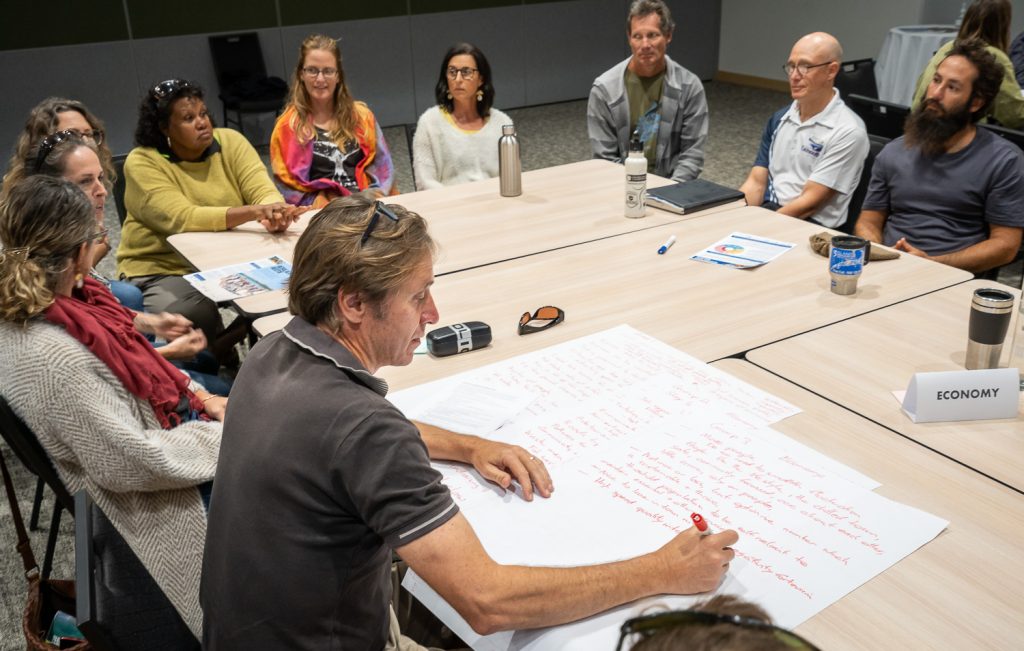
Community workshops with diverse stakeholders generated 200+ potential resilience actions and generated enthusiasm and buy-in from participants. Photo © Joel Johnsson, DBCA
The Strategy Process image below illustrates how learnings from stakeholder engagement were combined with other inputs to develop the Resilience Strategy.
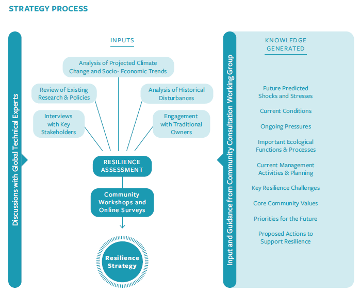
Ningaloo’s process for developing the Resilience Strategy. Photo © Joel Johnsson, DBCA
How successful has it been?
Our process was perceived as fair and equitable by stakeholders. As with many contentious issues, it is unreasonable to expect all parties will reach consensus or agree about the final decisions. We worked hard to ensure that all stakeholders felt they had the opportunity to voice their opinion and could see how it was considered within the decision-making process. We also built support and partnerships for ongoing management. Through this process we generated enthusiasm and buy-in for actions which empowered the community to be involved in management.
The engagement process targeted a much broader set of stakeholders than had been done in the past. This whole-of-community approach meant extra work to implement but resulted in empowered and engaged participants and more than 200 proposed reef management actions, 140 of which formed the backbone of the Resilience Strategy for the Ningaloo Coast.
What’s Next? Ningaloo will release the strategy later this year (2022) and move into implementation—delivering on ground action, policy reform, and other strategies to strengthen the reef and community for an uncertain future. Ningaloo and Resilient Reefs Initiative partners delivered a resilience accelerator workshop in 2021 to deepen engagement on a specific topic: reef restoration (see workshop reports here). The other pilot sites in the Initiative are also developing holistic resilience strategies based on deep stakeholder engagement and we look forward to sharing those examples over the next few years.
It was great for everyone to have their voices heard. At the end of it, you could tell everyone was really energised; no-one had had that kind of opportunity to contribute before, and you finally felt like something that you really cared about and thought was important for the future had been heard… I’m really excited to see what the next steps are, how we can foster that energy that Resilient Reefs has created and make a positive change for the community and the region.
-Michael Tropiano, Exmouth resident
Lessons learned and recommendations
- Build momentum:
Once you have identified key stakeholders, what they are concerned about, and how you will engage them, you need to build momentum and interest in the process to get participation. We achieved this by:
- Establishing credibility: The best way to establish credibility with local stakeholders is to get the endorsement of influential members of each group. We established a community consultative committee of 11 representations from different stakeholder groups which provided project guidance. Representatives were credible sources of information for stakeholders, sometimes presenting at the workshops, and helped to encourage participation.
- Identifying key allies: When conducting workshops, we invited a core group of stakeholders that were crucial to the success of the process (including specific management agencies, Traditional Owners, etc.). Having these participants ensured that a diverse range of voices were represented, regardless of other participants. We also used the ‘snowball technique’ by asking them to invite other people within their networks.
- Raising awareness: We ran events that raised awareness about the workshops and the issue we were seeking to address. For example, we screened climate change and coral reef documentaries at local venues and hosted a ‘Reef Chat’ about the current state of knowledge to encourage people to participate in the workshops.
- Communicating broadly: We communicated through a broad range of channels, using social media, traditional media (news and radio), local newsletters, mailing lists, flyers on community notice boards, and presentations at community group meetings and local events.
- Reduce barriers:
In all circumstances there will be barriers to participation. If you can reduce these barriers, more people will be able to engage and the process will be more successful. Here are some of the barriers we identified within our community and how we addressed them:
| Barrier: | How we addressed it: |
| The elderly or those without access to internet may find it difficult to access online surveys. | Paper surveys were also provided, along with the offer of an in-person discussion. |
| People often find it hard to attend workshops due to other commitments. | We identified all weekly activities within the community (council/committee meetings, social sports, events, etc.) and scheduled workshops at times which avoided conflicts. |
| Families struggle to find childcare during the evenings so that both parents can attend events. | We organised supervised activities for children at workshops to enable families to attend without hassle. |
| Young people are often overlooked during formal engagement activities. | Running activities which were specifically designed for young people in parallel with adult sessions allowed us to engage meaningfully, and also to share the values and priorities of young people with the adults in a structured way to inform each discussion. We also explored running activities at the local school. |
| Venues for workshops or interviews, or certain methods of communication, may not be accessible for people with disabilities. | All venues were confirmed to be fully accessible. Important information was communicated both in print and via video/audio recordings. |
| Some outspoken or aggressive individuals within the community had the tendency to dominate discussions and discourage other contributions. | Much of the workshops were designed around multiple small-group discussions – if one group was being dominated by an individual, others could simply join another group. There was also time for scheduled personal reflection, which was shared on post-it notes, and people were given opportunities to anonymously vote and show support for ideas. Clear ‘rules of engagement’ that outlined how people would be held accountable in interacting with each other (treating each other with respect, sharing the time, etc.) were explicitly stated and agreed upon by the whole group at the start of each session, and enforced during activities. |
| The community is seasonally transient, with many locals leaving in summer. | Key engagement activities, such as workshops and interviews, were postponed until a high proportion of stakeholders could attend. Options for online participation were also developed. |
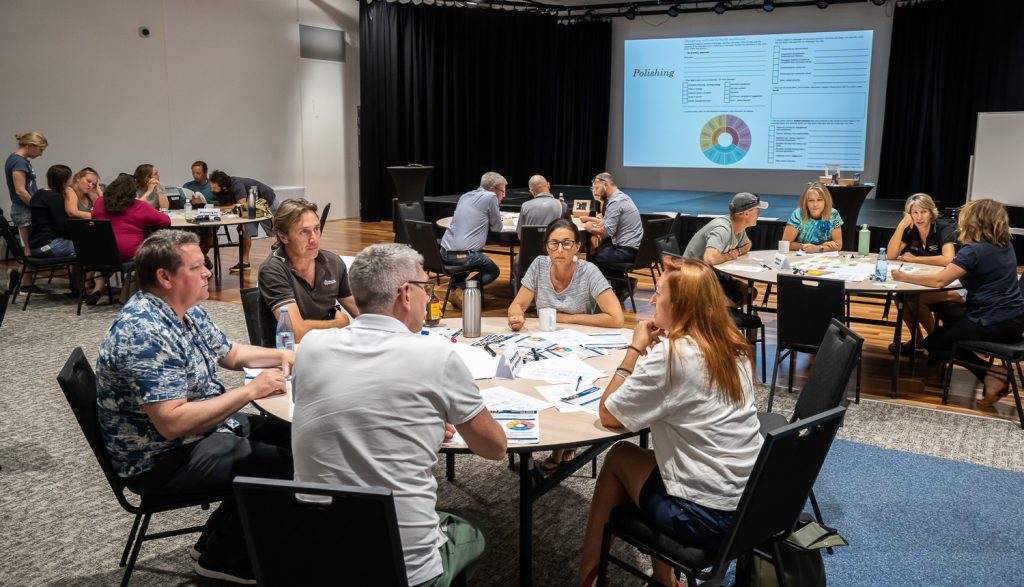
Community members worked together to develop proposals to strengthen the resilience of ecosystems, communities and governance systems along the Ningaloo Coast. Photo © Joel Johnsson, DBCA
- Engage meaningfully:
Providing the opportunity for stakeholders to engage meaningfully was the most important concept that guided the process. This was about ensuring all participants felt comfortable contributing and that their views were being considered equitably. There are a range of important approaches that allowed participants to engage meaningfully, many of which related to the design of workshops:
- Transparency from organisers is fundamental. Transparency is about being clear with participants about intentions, the process of engagement, and how the information they provide will be used.
- Attending interviews and workshops with questions, not answers is important for genuine engagement. Having an open discussion about key issues, values, and threats and how these should be addressed, rather than just proposing actions, meant people felt the process was genuine and were much more excited and empowered about the outcomes.
- Identifying common ground and shared values between the participants helps defuse potential conflict. Early in the workshop we did an exercise that mapped what the reef means to community members, which highlighted how much people valued the reef as a core aspect of living in the community. While people eventually differed on which actions were needed, we highlighted the shared values and common ground to decrease division.
- Providing information to inform discussions was important and gave a sense of equity – we asked for input from participants and in return shared the results of our research. By asking for input first we did not lead the discussion towards predetermined outcomes. In many cases, people were given the opportunity to express their opinions and personal experiences, then were presented with data and provided an opportunity to build on or add to their responses based on this new information.
- Having unbiased small-group facilitators is key to an inclusive process. Workshop moderators provided facilitation, to each small-group discussion by taking notes, directing participants through activities, and reporting back to the organizer/clarifying points after the workshop was complete. All ideas and input was considered regardless of whether it fit with the moderators’ (or other members of the table) views or opinions.
- Establishing legitimacy is key. Legitimacy was enhanced by: 1) video presentations by global technical experts in the field of reef resilience; 2) a quick ‘who’s in the room’ announcement at the start of the workshop to highlight the broad participation by decision-makers at the workshop; and 3) having influential members of the community present information, rather than managers.
- The ability to interactively discuss ideas in light of the input/perspective of other community members was paramount. Activities were designed to be both interactive and engaging. This allowed participants to understand their views in the context of broader perspectives; pushed people to iterate, innovate, and adjust their thinking on the basis of this context; created opportunities for learning and development of common values; and provided a ‘natural filter’ for preferred projects. Furthermore, planning activities which were different from simply brainstorming or presenting meant the sessions were more engaging. Activities included video presentations, collaborative risk assessment, small-group thematic discussions (‘World Café’), visioning/scenario planning, and an action design session which included voting.
It’s one of those things that you hear a lot about, but sometimes don’t actually see: that communication with community, as well as between management agencies. It was really good to see the community and DBCA all working together, addressing issues and potentially solving some problems. I left the workshops feeling more connected to the community, with a clearer understanding of DBCA’s aims. It left me feeling really inspired and energised to do more. I was buzzing!
-Caitlin Rae, Coral Bay resident
Funding summary
The Resilient Reefs Initiative is being delivered in Ningaloo by the Department of Biodiversity, Conservation, and Attractions (DBCA) in collaboration with the Great Barrier Reef Foundation, The Nature Conservancy’s Reef Resilience Network, Columbia University’s Center for Resilient Cities and Landscapes, Resilient Cities Catalyst, UNESCO and AECOM. The initiative is enabled by the BHP Foundation. Approximately $485,000 AUD has been provided to DBCA to fund the Chief Resilience Officer position and cover expenses for three years. In-kind resources to support strategy development are provided through program Partners (see list below) and the delivery partner AECOM. Upon the release of the Resilience Strategy, up to $1 million in seed funding is available to implement innovative resilience actions.
Lead organizations
Implementing organization in Ningaloo: Department of Biodiversity, Conservation, and Attractions
Lead organization for the Resilient Reefs Initiative: Great Barrier Reef Foundation
Resilient Reefs Initiative funder: BHP Foundation
Partners
Reef Resilience Network
Columbia University’s Center for Resilient Cities and Landscapes
Resilient Cities Catalyst
UNESCO
AECOM
Resources
Resilient Reefs Ningaloo by the Government of Western Australia Department of Biodiversity, Conservation and Attractions

